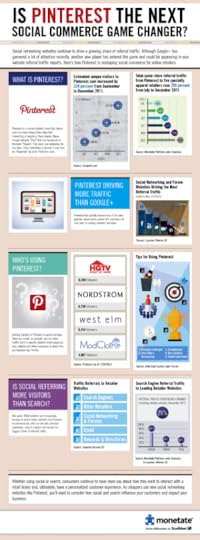Jacob S Paulsen's Blog, page 21
June 20, 2012
The Art of Split Testing: Online Marketing Strategies
 Split testing is the basic process of trying two very similar things to see which is more effective. With Internet marketing this could be two banner ads, landing pages, email scripts, or subject lines. Split testing is a good thing to try whenever you are trying to determine the most effective copy, image, or headline for… well anything. In fact in Timothy Ferris’s book, The Four Hour Work Week, he explains how he even used split testing with online ads to determine the best title for his book. Here are some basic rules I like to follow with split testing my campaigns.
Split testing is the basic process of trying two very similar things to see which is more effective. With Internet marketing this could be two banner ads, landing pages, email scripts, or subject lines. Split testing is a good thing to try whenever you are trying to determine the most effective copy, image, or headline for… well anything. In fact in Timothy Ferris’s book, The Four Hour Work Week, he explains how he even used split testing with online ads to determine the best title for his book. Here are some basic rules I like to follow with split testing my campaigns.
Test Everything. Test PPC campaigns, banners, emails, headlines, etc
Have a plan to measure results. Depending on the campaign you might have a built in measurement system but sometimes you have to get creative about how you will determine which is more effective
Test only one variable at a time. If running ads on Facebook you shouldn’t run two ads that have different headlines, images, and body text. Run two ads that are the same with only one variable different so that you can actually draw a conclusion about what is and isn’t effective.
After you figure out what is effective, split test again. Just because one is better than the other doesn’t mean it’s the best possible option.
Don’t draw conclusions from too little data. You have to run the test through a significant amount of volume before you settle on the results.
I recently started wondering about the street beggars I pass downtown. I want to do some split testing with their business to determine the best signage, locations, accessories, facial expressions, etc. There are best practices for everything and I find myself wanting to split test everything in life. Any other ideas of what would be worth split testing?
[image error]






June 4, 2012
Hootsuite Removes Ping.fm Integration But Adds Many Others
When I logged into my Hootsuite dashboard this morning there was a warning about Hootsuite discontinuing Ping.fm support on June 8th. According to the Hootsuite website, while removing Ping.fm support, Hootsuite will be adding support for many other services.
If you aren’t familiar with Hootsuite, you really need to check it out. Hootsuite is a social media client management software. It allows you to monitor, leverage, and publish to your various social media profiles. Over time Hootsuite and left most of its competitors in the dust as their product has become more polished and user friendly.
Since the beginning of Hootsuite they have supported Ping.fm. Ping.fm is what I would call a status update syndication service that allows users to publish an update to all the various social networks at once. I used to use the Ping.fm service a lot several years ago but as my focus has narrowed into just a few platforms, my need for Ping.fm has dwindled. I’m not particularily sad or effected by Hootsuite’s decision to discontinue support, but I am VERY excited about what other services they may be adding to replace it.
According to the Hootsuite site, Tumblr, MailChimp, Get Satisfaction, YouTube, Flickr and Digg and among the new services that Hootsuite will be adding to the mix. This could make a huge impact on Hootsuite’s growth and allow current customers to better manage their ever widening social media focus to other platforms.
More information on the Hootsuite site http://help.hootsuite.com/entries/214...
[image error]






May 29, 2012
Pinterest Making A Splash
 I know I’m a little late to be talking about the latest in Social Media news, Pinterest. About 3 or so months ago it seems that everyone was talking about Pinterest with the release of some new research data. Turns out that this picture-based social network is growing faster than any of its competitors and for many internet marketers and business owners, Pinterest is a game changer.
I know I’m a little late to be talking about the latest in Social Media news, Pinterest. About 3 or so months ago it seems that everyone was talking about Pinterest with the release of some new research data. Turns out that this picture-based social network is growing faster than any of its competitors and for many internet marketers and business owners, Pinterest is a game changer.
If you don’t know what all the hype is about I suggest just going and setting up an account. Essentially users “pin” content from around the web to their Pinterest “boards.” Boards are collections of content that you want to share with the world. When content is pinned to Pinterest it is displayed as a picture. This has made the network especially popular in regards to visually appealing content like food, fashion, and famous people (Did you notice the alliteration?). This of course leads to a female skewing audience which just happens to be the primary target demo for many advertisers.
For myself I’m finding it enjoyable. I like creating different boards and filling them with my various internet wanderings. I’m surprised at how quickly people tend to find and re-pin my posts. For a few of the blogs in our network we have also noticed as much as 5% of our site traffic now coming from Pinterest. I’ll take that all day long.
The infographic to the left was done by @monete. Send them props for the great information.
[image error]






May 23, 2012
Book Review: The Zigzag Principle by Rich Christiansen


I read this book as part of the 12 Books online book group during the month of May 2012. I admit that when I first read the title I was a little confused. I love anything to do with entrepreneurship despite my rather poor track record thus far. The reason I was so excited to read this book is because the author has just an established track record in starting successful companies. Rich has launched over 30 companies with less than $10K in capital and among those over 10 went on to be BIG successes.
The book is really about helping entrepreneurs understand that the best way to get somewhere isn’t always a straight line. In my reading, this major concept took a little while to sink in but as I moved from chapter to chapter I really discovered that the material is designed to give an entrepreneur a new type of road map that allows one to chart a course that is most likely going to lead to success.
The three main zigs and zags were critical components that talk about things that most of us understand are critical to success. Getting to profitability quickly, failing efficiently, adding resources, scaling the business, setting goals, and motivating a team. Most students of business are already familiar with these necessities but having them as part of an effective road map is the key to getting off the ground.
As I reflect on my reading of the book I feel like there were a few golden nuggets that will really stick out to me as I move forward in my career.
First, as elementary as it sounds, I think a key insight for me was the need to get to profitability before scaling the business. All too often I think people (myself included) are too eager to make the business big before we discover the key system that generates profits on a consistent basis. The Zigzag Principle taught me that you always focus first on a profitable and dependable model before you invest in scaling the business.
Second, Rich’s insights about living a life of balance were really compelling. I have fallen victim one too many times to the attitude of “just this one big project” and I’ll be able to spend more time with the family (or insert other life goal). There will always be one more project, trial, or other issue. As individuals we have to determine what our real goals are and create “guardrails” that keep us on our path and within our boundaries in business and every other aspect of life.
A great read and a great experience with the author as part of the book group. If you are reading this before March 25, I would invite you to join me in a live Q&A with the author. http://www.12booksgroup.com/may2012webinar
[image error]






May 14, 2012
5 Places to Get Blog Ideas and Content – No More Excuses
 Do you sometimes feel dried up when it comes to finding new things to blog about? I have found that when it comes to writing, sometimes the juices just don’t want to flow. Outside of reading a great book called “Finding Your Flow” back in January I have often found that the following strategies are a good way to drum up some ideas and content.
Do you sometimes feel dried up when it comes to finding new things to blog about? I have found that when it comes to writing, sometimes the juices just don’t want to flow. Outside of reading a great book called “Finding Your Flow” back in January I have often found that the following strategies are a good way to drum up some ideas and content.
Google Analytics: The first place I look for good insights is in my Google Analytics data. First, I check the content section. Knowing which articles and pages are the most popular will help you understand what topics are of most interest to your current website visitors. Be sure to use a broad date range to shake out any new articles that have found temporary fame. Second, check the search traffic source page to see what keywords and phrases are bringing people to your site. If you have found some search engine luck in a few phrases or words build off of them to solidify your positioning.
Suggestion Box: Everyone is anxious to get the word out about their latest product or idea. Often times you can glean some excellent content ideas by allowing your blog visitors to submit their suggestions. I generally do this by setting up a content suggestion page or widget (depending on how much you want to encourage input).
Topic Discussion Forums: Whatever your topic and niche is I’m confident that there is a forum/online discussion board somewhere online where people with that interest have conversations. Visit that forum and setup an account. Browse the most recent topics and look for the common questions or unanswered questions that you could answer with a blog post. This has the added benefit of driving traffic to your blog by posting your blog post as an answer to people’s questions.
LinkedIn Groups: Same concept as above. LinkedIn groups are very popular and you can almost always find a group specific to your topic. Join and sign up for the daily or weekly email digest. This will show you what topics are most trending and most difficult for people to answer/address.
Use Twitter and Facebook to Ask: Since social media is all about conversations, why not start one by asking people what questions or concerns they have about your topic? You will be surprised how much response you get. This is also a great way to ensure that after writing your blog post you have a few people who are very likely to go visit your blog.
What other ideas do you have to keep the blog post ideas flowing?
[image error]






May 11, 2012
My Personal Management and Organization System
 A close friend and business partner recently asked me about my own systems for managing emails, task lists, and generally organizing stuff. I’m confident that I don’t have the best system in place but its working for me right now. Here is the outline I sent to my friend.
A close friend and business partner recently asked me about my own systems for managing emails, task lists, and generally organizing stuff. I’m confident that I don’t have the best system in place but its working for me right now. Here is the outline I sent to my friend.
Organizing and Managing Email:
I use Gmail’s priority inbox which creates three sections of content: Important and Unread, Starred, and Everything else. About 4 times per day (or more often if I have dead time or transit time) I process incoming mail. Processing incoming mail consists of opening and reading ALL unread email. After opening and quickly evaluating the email I either: Star it (important and requires action), Archive it (may need later but requires no action), Delete it, or do nothing (not important but requires action). This leaves me with a clear set of important emails/tasks that are displayed as starred in my priority inbox. Everything else in the inbox is in the not-important but requires action area below. I try to never have more than 10 starred emails.
In-boxes (more generally speaking):
I capture all thoughts and tasks and stuff that requires action in one of three in-boxes. This is a lesson I gleaned from Getting Things Done: The Art of Stress-Free Productivity
First is email and I’ve already covered how I manage that inbox.
Second is my to-do list. I use Google Tasks to manage my task list. Its always available on the computer in my Gmail and Calendar keeping it top of mind. It isn’t the most robust interface (Google needs to step it up here) but it fits my needs. It will allow you to assign due dates and input notes per task. I use an app on my iPad called GoTasks (also available on iPhone) that syncs flawlessly with Google Tasks and has a very robust interface that allows you to stack additional features, such as task reminders, on top of Google Task’s feature set. On my Android phone I currently use an app also called GoTasks (not the same developer). It syncs perfectly as well, and is the best option if you have more than one Google Account where you need to sync tasks. If you only have one Google account where you need to sync I would recommend an app called Tasks N Todos which has a much cleaner interface. EVERYTHING goes into this inbox. Every random thought or consideration must be archived by category (Family, Church, Business, etc).
Third is the home inbox. This is a physical red basket kept on our kitchen counter. Warranties/receipts, mail, and other notes and reminders find their way into this inbox. I check it every day and try to keep up on it the best I can.
Regular Planning Sessions
The most critical regular planning session is EFC (Executive Family Council). My wife and I sit down on Sunday evenings after the kids go to bed and plan the week. Topics include: Budget and Finances, Church Work, Week’s Calendar, Family Night (Mondays), Date Night, and our current Spiritual Book that we are reading as a couple. This doesn’t generally take more than 30 minutes. The calendar is generally fast because when either of us adds something to our own calendar, that at all involves the other person, we always send a calendar invite. Also worth noting is that we have 2 tools that we use to manage finances. The first is Mint.com and the second is a Google Doc Spreadsheet we call “This Month.” Its a daily inflow/outflow worksheet that allows us to plan every expense and inflow to maximize our savings and ensure we never have a negative balance.
Personal Daily Planning: This is a 3 minute nightly review of the next days activities. Just reminding myself if I need to wear anything specific (like a tie) and if I need to leave early or take anything with me outside of normal.
Tools I use religiously:
Desktop:
Evernote
Google Tasks
Gmail / Google Calendar
Google Docs
Dropbox
Splashtop (for connecting to my other computers)
My Android/iPad:
Evernote
GoTasks
Gmail / Google Calendar
Google Docs
Dropbox
Splashtop / PhoneMyPC
Documents to Go
NewsRob / FeedlerRSS (Google Reader Sync)
Mint.com
Paypal
What are some of the systems or tools that you have found work best for you and your family?
[image error]






March 30, 2012
Survey: Webinar Experience and Lessons Learned
jQuery(function($) {
$('form#survey-7').bind('submit', function() {
$('#submit').attr("disabled", true);
});
$(':input.Other').bind('click', function() {
$(this).prev().prev().attr("checked", "checked");
});
// set the default survey error handler
$.fn.form.setErrorHandler('default', function(errors) {
var form = $(this);
// remove the error messages
form.find('.Widget div.Error').remove();
// foreach error, insert them
$.each(errors, function(errorIndex, error) {
// fields with the same name represent radio and checkboxes
var fieldsWithSameName = form.find('[name="' + error.field.attr('name') + '"]');
// put a error message after the widget title, but do it only once for each widget
if (fieldsWithSameName.index(error.field) == fieldsWithSameName.length - 1) {
//error.field.closest('.Widget').find('label:first').after('
' + error.message + '
');
error.field.closest('.Widget').find('label:first').after('
' + error.message + '
');
}
});
// focus the first error field
errors[0].field.focus();
// and alert the first error message
alert(errors[0].message);
$('#submit').removeAttr("disabled");
});
// initialize the survey validator
$('#survey-7').form().init({
errorClass : 'Required'
});
$('#survey-7').form().getFields().each(function() {
var field = $(this);
var label = field.closest('.Widget').find('label:first');
flabel = label.text();
flabel = flabel.replace(" *",""");
field.form().setErrorMessage('required', 'The "' + flabel + ' field is required.');
});
// language pack the error messages
$('#survey-7').form().setErrorMessage('required', "This field is required.");
// "Other" fields must not be empty if their corresponding
// radio button is checked
$('#survey-7 :input.Other').form().setDependency(function(field) {
if ($(this).siblings(':radio:checked, :checkbox:checked').length && $.trim($(this).val()) == '') {
$('#submit').removeAttr("disabled");
return false;
}
return true;
}, "Please type an answer in the text box next to the checked field.");
// disabling button on submit
//alert( $('.required:first').form().getErrorMessage() );
});
Webinar Experience Survey
Please answer these questions about your experience in attending webinars
How Often Do You Attend Webinars? *
Several Times Per Month
Once or Twice Per Month
Less than Monthly
Almost Never
Never
What Types of Webinars Have You Attended? *
Select All That Apply
For Work
For a Side Job/Business
For My Personal Development
For a Hobby or Topic I Enjoy
What Time Is Most Convenient For You To Attend A Webinar? *
Before my work day
Evenings
During Morning Business Hours
During Afternoon Business Hours
Weekends
If You Are Not In Front Of Your Computer Would You Still Call In For The Audio? *
Yes
No
Maybe
Which of the Following Engagement Activities Do You Feel Are Important in a Webinar? *
Check All That Apply
Live Q&A
Text Chat
Video Streaming
Access to Downloads and Files
Polls and Surveys
Other:
Submit Response
[image error]






March 23, 2012
3 Other Great Places to Buy PPC Advertising
 Are you tired of Google Adwords ppc campaigns? I'm as big a fan of buying ads from Google as the next guy but sometimes you need to try new things. There are some great other sites out there where I think you will find its really easy to target your customers.
Are you tired of Google Adwords ppc campaigns? I'm as big a fan of buying ads from Google as the next guy but sometimes you need to try new things. There are some great other sites out there where I think you will find its really easy to target your customers.
I'm not talking about Facebook. Of course you should be buying PPC on Facebook. Its the epitome of targeting but most everyone knows about it these days (which is why it seems to be getting more expensive).
What is the next pay-per-click frontier… I think these are among the options:
Goodreads: Goodreads.com is the largest and fastest growing social network built around books, book reviews, and book clubs. Stop to think about your target market. Don't you think it would be easy to identify and target your potential customers/clients based on what books they probably read? I have found that this is generally the case. You can target by normal demographics but you can also target by book, genre, or author.
Twitter: You can buy targeted and promoted tweets and trends directly from Twitter.com. You can also use a 3rd party like SponsoredTweets. Either way it tends to be easy to target users based on what hashtags they use and who they follow. Good chance that everyone who follows ESPN is interested in sports.
LinkedIn: The site isn't new but did you know you can buy ads there? It isn't as saturated as Facebook and you can still target your audience effectively without a large budget. Just navigate to LinkedIn.com and look for the Advertising link at the bottom of the page.
Where else have you found success with your targeted ppc campaigns?
[image error]






February 29, 2012
Sponsored Tweets Setup Tutorial Video
I wrote an article a few months ago about this great program for generating some extra revenue from Twitter. If you prefer written directions I would go back to that article. Here is a supplementary video:
[image error]






February 22, 2012
The Three Cs of Internet Marketing
When I sit down to talk to clients about their internet marketing strategy I'm often surprised how quickly the conversation gets lost in details and lacks clear objectives and goals. After all when you sit down in a meeting you want to have a clear idea of what you plan to discuss and what you want to achieve. Often however, because I'm a professional in the space I forget that the plan inside of my head may not make complete sense to my client when I try to explain it.
 That is why I now always talk about the three Cs of Internet Marketing. This gives me a framework around which I can organize my thoughts and in which the clients can better understand the complete strategy and action points. The three Cs are in a certain chronological order and need to be addressed accordingly. Strategies revolve around these three points and always in this order.
That is why I now always talk about the three Cs of Internet Marketing. This gives me a framework around which I can organize my thoughts and in which the clients can better understand the complete strategy and action points. The three Cs are in a certain chronological order and need to be addressed accordingly. Strategies revolve around these three points and always in this order.
Content
Your internet marketing strategy starts with creating content. It doesn't matter if you are a plumber, blogger, or widget salesperson; you must create online content. Content is IMPORTANT because it sets the stage for everything else you do. Creating content gives you added credibility in your profession. Content gives you informational products to offer to entice people to join your email lists etc. Content gives you something to publish to social media networks on a regular basis. Content gives search engines something to read and index in reference to your website and what you are about.
At the very beginning you must map out an internet marketing content strategy. Use these questions as a guideline to help you define your content strategy:
What are you going to write about? It should be related to your industry/products/services. It should have a wide audience. It should be generic enough that you can create endless amounts of content moving forward.
Where will you need to publish the content? Your blog is an absolute must but you may need unique content for newsletters or info products to giveaway.
How often do you need to produce content? Consistency is key so decide in the beginning how often you can commit to publishing new content.
Community
The second C is all about getting visitors to your site and followers in your social media and email lists. One time visitors to your website are an important part of your community plan but ultimately they will come as a bi-product of your focus on content and building the other communities we will discuss.
You should really be focusing on getting more people to join your email list, Facebook Page, Twitter Profile, YouTube Channel, and any other social profiles you focus on. Just creating content and sending it out to the world is not enough to believe that people will just start to find and follow you in these different mediums. Here are some pointers to consider as part of your community internet marketing strategy:
Putting a widget (like the one over there on the right) on your website that quickly allows visitors to find your social media profiles is a good idea but don't think it will be enough all by itself.
Building a Twitter following is as easy as being able to target your audience and then follow them, and give them ample reason to follow you back. Here is a larger overview of the software and strategy I recommend. Here are other Twitter tutorials.
Building a Facebook following is more difficult that Twitter because you cannot solicit users and ask them to "like" your page. You need to use your other communities (offline and online) to drive people to like your page, and this will go much more smoothly if you give people an incentive to "like" you there. Do product and service giveaways and contests. Produce unique (valuable) content that can be found exclusively on your Facebook page.
Building your email database is as simple as giving people a compelling reason to join your list. Offer a Free Report, a Free Preview/Trial, Free Training or Video Tutorials, or an E-Book. The more compelling the offer the more likely people are to give you their information.
Commerce
This tends to be the easiest part of the strategy for most of my clients. Most of us already know how we want to make money on our website. The bigger problem tends to be in getting enough eyeballs to look at what we are doing and offering. In case you don't know fully how you can profit from your website and it's content read this guide that explains how websites make money.
Commerce boils down to providing products that are targeted for your audience. This doesn't mean you have to produce or sell the products yourself. Many website publishers generate their revenue in affiliate marketing opportunities.
I hope the three Cs of internet marketing serve you as a road-map the same way they have served me and the many advertisers and small businesses that I work with around the country!
[image error]





























